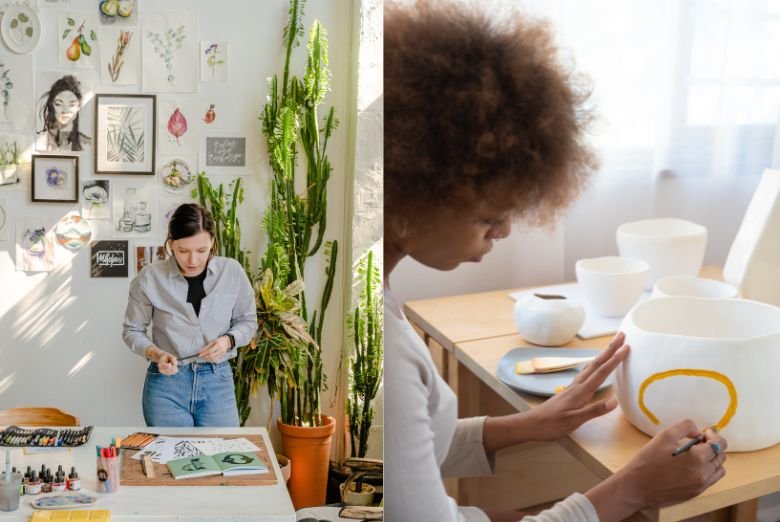How does color affects one’s mood? Colors are more than mere visual stimul. They possess the power to influence our emotions and shape our moods. The study of color psychology delves into the intricate relationship between different hues and the human psyche. From calming blues to invigorating reds. Home & Garden each color has a unique impact on our mood. In this blog post, we will explore the fascinating world of color psychology, drawing insights from historical perspectives and contemporary research to unravel the ways in which colors can affect our emotional well-being.
Historical Perspectives
- Johann Wolfgang von Goethe’s “Theory of Colours” (1810) laid the groundwork for understanding the psychological impact of colors. Goethe proposed that colors could evoke specific emotional responses, influencing one’s mental state.
- Faber Birren’s work, particularly “Color Psychology and Color Therapy,” expanded on Goethe’s ideas, suggesting that colors could stimulate or calm the nervous system.
- Eva Heller further contributed to the field by exploring the emotional and psychological associations of different colors.
Diving more into Literature…
- According to Johnson (2007), color does affect mood by producing certain chemicals and stimulating different feelings such as hunger. For example, blue can make one feel calm because it releases calming chemicals, and red can make one hungry because it is an appetite stimulant. Yellow can make one feel irritated, and it is a fact that people lose their temper most in yellow rooms. However, pink is tranquilizing and can make one feel weak. In conclusion, Johnson says that depending on the color, one’s body can do things (like producing chemicals) that cause a certain emotional reaction (mad, sad, etc.).
- Another idea, by Smith (2007), is that the effect color produces is based on what one’s body does in response. For example, yellow is mentally stimulating, and activates memory, whereas red increases confidence. Also, brown can make a person feel orderly and stable, while a dark blue can make one feel sad. Therefore, Smith says that different colors do in fact change one’s mood and the consequences can be negative or positive.
- A third writer, Wollard, (2000) seems to think that color can affect one’s mood, but the effect also can depend on one’s culture and what one’s personal reflection may be. For example, someone from Japan may not associate red with anger, as people from the U.S. tend to do. Also, a person who likes the color brown may associate brown with happiness. However, Wollard does think that colors can make everyone feel the same, or close to the same, mood. According to Wollard, pink reduces aggression, which is why the walls of the jail cells in the Seattle prison are pink! Also, brown can make one feel comforted. Additionally, Wollard believes that environment and personal experiences play a role in shaping mood. Furthermore, he suggests that individual differences can also impact how colors are perceived. On the other hand, cultural influences may also play a part in how people respond to colors.
- Eric, John, and Paraag’s (2007) main point about color psychology is that color has both a physiological and psychological effect. For example, green makes people feel relaxed because it relaxes their muscles and makes them breathe deeper and more slowly. Furthermore, blue lowers blood pressure, which makes one feel calm. Eric, John, and Paraag conclude that color affects one’s mood because of what it does to the body.
Scientific Advances in Color Psychology
Additionally, these studies have provided insights into the way the brain processes and interprets color information. Moreover, they have helped researchers better understand the complex interplay between different brain regions involved in color perception. Furthermore, the findings have implications for various fields, including psychology, neuroscience, and even design and marketing.Different colors activate distinct brain regions associated with emotions, memory, and decision-making.
Few Colors and Their Emotional Associations
1. Blue
- Often associated with calmness and tranquility.
- Research suggests that blue can lower heart rate and blood pressure, promoting a sense of relaxation.
2. Red
- Elicits strong emotional responses associates with passion and intensity.
- Studies indicate that exposure to red may increase arousal and stimulate appetite.
3. Green
- Linked to nature and feelings of renewal.
- Green is often considered a color of balance, promoting a sense of calm and harmony.
4. Yellow
- Associated with energy and happiness.
- Studies suggest that yellow can stimulate mental activity and promote a positive mood.
5. Purple
- Often linked to luxury and sophistication.
- Purple may evoke a sense of mystery and creativity.
Applications in Everyday Life
1. Home Décor
- Calm Bedrooms: Use calming colors such as soft blues, greens, or neutral tones in bedrooms to create a serene and restful atmosphere, conducive to relaxation and sleep.
- Energetic Spaces: Infuse energy into communal spaces like the living room or kitchen with warm and vibrant colors like yellows and oranges.
2. Workspaces
- Productivity Boost: Incorporate shades of blue or green in workspaces to enhance focus and productivity. These colors associates with calmness and concentration.
- Creativity Hubs: Introduce stimulating colors like red or yellow in areas where creativity is encouraged, such as art studios or brainstorming spaces.
3. Learning Environments
- Conducive Classrooms: Choose colors like green or light blue in educational settings to create a positive and comfortable learning environment. These colors link to improved focus and retention.
4. Healthcare Settings
- Healing Spaces: Hospitals often opt for soothing colors such as soft greens or light blues in patient rooms to create a calming and comforting atmosphere, promoting healing.
- Positive Distractions: Pediatric areas may incorporate vibrant and cheerful colors to distract and uplift the spirits of young patients.
5. Retail and Marketing
- Brand Identity: Businesses strategically use colors in branding to convey specific emotions and messages. For instance, red may evoke urgency and excitement, while blue can signify trust and reliability.
- Consumer Influence: Retail spaces utilize colors to create an inviting and enjoyable shopping experience. Warm colors may encourage impulse buying, while cool colors promote a more relaxed shopping atmosphere.
6. Restaurants and Food Industry
- Appetite Stimulation: Warm colors like red and orange are often used in restaurants to stimulate appetite and create a lively atmosphere.
- Relaxing Cafés: Cafés and eateries looking to provide a relaxed environment may use calming colors like muted greens or blues.
7. Transportation and Signage
- Safety Signage: Colors are crucial in conveying messages in signage. Red is commonly used for stop signs and alerts, while green signifies safety or direction.
- Public Transport: Transport interiors may use calming colors to create a comfortable journey experience, while alerting colors are used for safety instructions.
8. Personal Wardrobe Choices
- Mood Expression: Individuals often choose clothing colors based on their emotional state or desired mood. Vibrant colors for celebrations, calming tones for relaxation, or professional colors for business settings.
Therefore, incorporating an understanding of color psychology into these everyday contexts allows individuals and designers to make intentional choices that positively impact mood and contribute to creating environments that align with specific emotional goals. Whether it’s at home, work, or in public spaces, colors play a crucial role in shaping our daily experiences.
Challenges and Controversies
Moreover, understanding how color affects one’s mood is a dynamic field, and it comes with its own set of challenges and controversies. Here are some key points to consider:
1. Cultural Variations
- Challenge: Colors can carry different cultural meanings and associations. For example, white is associated with purity in Western cultures, but it may symbolize mourning in some Eastern cultures.
- Controversy: Applying universal color psychology may overlook the nuanced ways cultures interpret and respond to colors.
2. Individual Differences
- Challenge: Personal experiences, memories, and preferences contribute to individual variations in color perception and emotional response.
- Controversy: Some argue that color psychology studies may oversimplify individual differences, leading to broad generalizations that don’t account for diverse responses.
3. Contextual Influences:
- Challenge: The impact of color can be highly dependent on the context in which it is presented. For example, red might be perceived as energizing in one context (e.g., sports), but alarming in another (e.g., warning signs).
- Controversy: Critics argue that color psychology research often fails to adequately consider the contextual factors that influence emotional responses to color.
4. Subjectivity in Research:
- Challenge: Studies on color psychology often rely on self-reported experiences, introducing a subjective element.
- Controversy: Critics argue that subjective responses may be influenced by factors beyond color alone, such as personal biases or expectations.
5. Limited Standardization
- Challenge: There is a lack of standardized methods for studying color psychology, leading to variations in experimental designs and measurements.
- Controversy: Without consistent methodologies, comparisons between studies become challenging, and the reliability of findings may be questioned.
6. Evolutionary Perspective
- Challenge: Some researchers argue that certain color preferences and aversions may be evolutionarily ingrained.
- Controversy: The debate centers around the extent to which evolutionary factors contribute to contemporary color preferences and whether cultural and societal influences play a more significant role.
7. Gender Stereotypes
- Challenge: Colors are often associated with gender stereotypes, such as pink for girls and blue for boys.
- Controversy: Critics argue that reinforcing these stereotypes through color choices may limit individual expression and perpetuate societal norms.
8. Ethical Considerations
- Challenge: The use of color in marketing and design raises ethical concerns about manipulating emotions and behavior.
- Controversy: Questions arise about the responsibility of designers and advertisers in using color to influence consumer decisions without explicit consent.
Therefore, in navigating the challenges and controversies surrounding how color affects mood, it’s crucial to recognize the complexity of individual and cultural differences, contextual influences, and the need for a nuanced understanding of the interplay between color and emotions.
In conclusion, the impact of colors on our mood is a nuanced and complex interplay between psychology, culture, and individual differences. By understanding how does color affects one’s mood, we can make intentional choices in our surroundings to create environments that positively influence our emotions. The rich tapestry of color psychology continues to unfold, offering insights that bridge the gap between aesthetics and emotional well-being. As we navigate the vibrant spectrum of colors in our lives, let us be mindful of the profound influence they have on our mood and embrace the potential for positive change that intentional color choices can bring.




Interesting, nice read